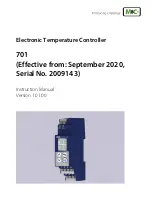
3-24
L30 LINE CURRENT DIFFERENTIAL SYSTEM – INSTRUCTION MANUAL
WIRING
CHAPTER 3: INSTALLATION
3
Application example
This example is for illustrative purposes only and the calculations present the worst-case scenario. In practice, the value of
debounce time can be lower.
Contact input ON state impedance used in the calculation of the discharge period is based on the following table.
Table 3-4: Discharge period
Debounce time setting = 2 ms
Assume a stray capacitance of 0.1
μ
F.
Assume an initial voltage across the stray capacitance "Vinitial" = 19 V (Vthreshold - 65 V), where Vthreshold = 84 V. The
initial voltage Vinitial depends on values of impedance of R1 and contact inputs when the contact input is OFF (non-
activated state).
Therefore, discharge time constant (
τ
) =50 k
Ω
*0.1
μ
F = 5 ms.
Discharge period t is calculated from the following equation:
Vthreshold = (Vbatt - VInitial) *e^ (-t/
τ
)
84 = -149 *e^ (t/0.005)
Eq. 3-1
T = -0.005 * ln (84/149) = 0.0029 s
Therefore, in this example the contact inputs operate.
To prevent this operation, the debounce time must be increased to 4 ms (set debounce time as per the following table) or
insert a resistor less than or equal to "R" as calculated later.
Table 3-5: Typical debounce time setting
* Default debounce time on contact inputs is 6 ms.
The value of this resistor "R" is calculated as follows:
1.
Determine the minimum voltage (V threshold) required to turn on the input. This is determined by direct measurement
or referenced in the input specifications.
2.
Calculate the resistance necessary to limit the voltage to 1/3 V threshold (when the contact is OFF, the non-activated
state) as follows:
R = (Vthreshold / 3) / (2 mA*)
Eq. 3-2
The 2 mA current is used in case the contact input is connected across the GE Form A contact output with voltage
monitoring. Otherwise use the amperage of the active circuit connected to the contact input when its contact output
is open and the voltage across the contact input is third trigger threshold to calculate the resistor value.
3.
When the contact is ON (operate state), the battery voltage appears across the resistor. The wattage rating of the
resistor is then:
PR = 1.3 * (Vbatt) ^2 / R Watts
Eq. 3-3
Battery voltage (V)
Input impedance (k
Ω
)
130
50
250
97
Stray capacitance (
μ
F)
Battery voltage (V)
Debounce time (ms)
0.05
130
2
0.1
130
4
0.2
130
6
0.05
250
3
0.1
250
6 *
0.2
250
11
Содержание L30
Страница 10: ...x L30 LINE CURRENT DIFFERENTIAL SYSTEM INSTRUCTION MANUAL TABLE OF CONTENTS ...
Страница 14: ...1 4 L30 LINE CURRENT DIFFERENTIAL SYSTEM INSTRUCTION MANUAL FOR FURTHER ASSISTANCE CHAPTER 1 INTRODUCTION 1 ...
Страница 126: ...3 68 L30 LINE CURRENT DIFFERENTIAL SYSTEM INSTRUCTION MANUAL CONNECT TO D400 GATEWAY CHAPTER 3 INSTALLATION 3 ...
Страница 214: ...4 88 L30 LINE CURRENT DIFFERENTIAL SYSTEM INSTRUCTION MANUAL FLEXLOGIC DESIGN USING ENGINEER CHAPTER 4 INTERFACES 4 ...
Страница 582: ...7 16 L30 LINE CURRENT DIFFERENTIAL SYSTEM INSTRUCTION MANUAL TARGETS MENU CHAPTER 7 COMMANDS AND TARGETS 7 ...
Страница 598: ...9 6 L30 LINE CURRENT DIFFERENTIAL SYSTEM INSTRUCTION MANUAL TESTING CHAPTER 9 COMMISSIONING 9 ...
Страница 622: ...10 24 L30 LINE CURRENT DIFFERENTIAL SYSTEM INSTRUCTION MANUAL FAULT LOCATOR CHAPTER 10 THEORY OF OPERATION 10 ...
Страница 670: ...A 18 L30 LINE CURRENT DIFFERENTIAL SYSTEM INSTRUCTION MANUAL FLEXANALOG ITEMS APPENDIX A FLEXANALOG OPERANDS A ...
Страница 678: ...C 6 L30 LINE CURRENT DIFFERENTIAL SYSTEM INSTRUCTION MANUAL COMMAND LINE INTERFACE APPENDIX C COMMAND LINE INTERFACE C ...
Страница 682: ...D 4 L30 LINE CURRENT DIFFERENTIAL SYSTEM INSTRUCTION MANUAL REVISION HISTORY APPENDIX D MISCELLANEOUS D ...
Страница 686: ...iv L30 LINE CURRENT DIFFERENTIAL SYSTEM INSTRUCTION MANUAL ABBREVIATIONS ...
















































